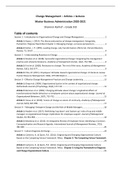Samenvatting
Summary Change Management (6314M0214Y) – Articles + Lectures Master Business Administration
- Instelling
- Vrije Universiteit Amsterdam (VU)
Summary Change Management (6314M0214Y) – Articles + Lectures Master Business Administration
[Meer zien]




